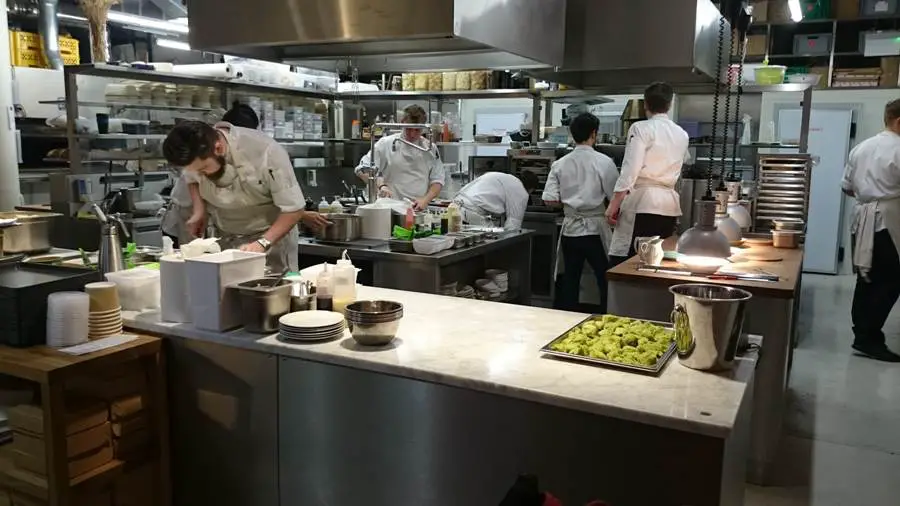
A commercial environment can be different regarding how things are applied, unlike the domestic setting.
The perception will always be that it is a business place, as such, the standard on how things are done must be professional.
As competition in business grows, companies will ensure they put in their best to remain in business.
Best practices to better serve guests or customers must be employed.
Attention given to hygiene in the kitchen will determine how neat and clean both personnel and facilities look.
No matter how busy the kitchen staff may be, issues about cleanliness have to be taken seriously…
The activities taking place in a production place can result in things being displaced. Utensils will be moved from one place to another.
Things or objects will have to change position due to activities in the workplace.
Getting things done will always be the focus of workers. Quality service to customers is the aim of the back-of-house staff.
Preparing meal orders timely will be the priority of the chef.
A food preparation place needs to be clean at all times. The activities for the production of food for human consumption can sometimes generate things that will be regarded as garbage.
Smokes can discolor walls, kitchen equipment, etc. Steams and bubbles that emanate from pans and pots during cooking can stain work uniforms.
The process of cooking can dirty pots and pans.
Materials for cooking food will not all be used, fractions will turn out to be refuse or garbage.
Hygiene practices are done to ensure bacteria don’t infect or contaminate food.
Individual Hygiene Of The Caterer
The first to be noticed in the kitchen is the personnel. Kitchen cleanliness must begin with personal hygiene.
Taking good care of oneself is the starting point of hygiene. A healthy lifestyle reflects the importance attached to cleanliness.
Chefs should engage in practices that will enable them to stay in good health conditions.
The grooming of the male caterer should always be intact: shaving regularly, and having moderate hair cuts and nails trimmed.
Female chefs should maintain grooming as well.
Uniform attire (chef white, trousers, etc.) should be neat and clean at all times.
Aprons should always appear clean — chef’s cap should cover hair properly, ensure it covers the hair — hair nets can be used alternatively.
Hand napkins should be clean at all times, disposable gloves should be used if available. Minor cuts or injuries should be treated and covered…
Always sanitize hands prior to hands-on activities.
Wear shoes that cover the feet and allow for easy movements.
Hands should be washed after handling raw food and using the toilet.
Use towels to dry or wipe hands after washing. Discard disposable gloves and hairnets after usage.
Cover nose or mouth with the elbow when coughing or sneezing
Head chef or kitchen manager should engage kitchen staff with talks daily, regarding maintaining personal hygiene. Training should be organized for food handlers periodically.
Food Storage Facility
Hygiene practices in a commercial kitchen extend to food storage facilities. As the outward cleanliness of this equipment is important, so also is the inside.
This hygiene relates to how the inside of the storage facility is kept clean, and the orderly arrangement of items within.
Refrigerators designated for dairy products storage should be maintained as such, and items within should be arranged neatly.
Chillers assigned for the storage of vegetables should be kept for perishables unless otherwise. Arrangements within should be orderly.
Freezers for frozen items should be maintained as such, poultry, meats, and seafood should not be mixed together.
Cooked meat or food should have its own separate chiller.
The way items are stored in chillers and freezers also reflects and shows the hygiene standard in the kitchen.
Cleanliness Of The Kitchen
General kitchen cleanliness is a teamwork, and should not be subjected to stewards alone.
Below are some things to prioritize:
Cutting Boards: Cutting boards should be used as color-coded for specific items. Example: blue board for seafood products, red board for raw meats, brown board for cooked meat, yellow board for poultry, and green board for vegetables.
After usage, boards should be disinfected, washed, placed in their racks, and allowed to dry for subsequent usage.
Work Table Surfaces: Clean-as-you-go practices should be applied to countertops and work surfaces.
Flattop Grills: Whatever item is cooked on the flat-top grill, the equipment should be kept clean immediately.
Microwave: As this apparatus performs tasks so helpful in kitchens, their hygiene should be maintained in and out.
Deep Fryers: After usage for the day business, the oil within, has to be drained, and the equipment cleaned. If the oil used appears dirty, it should be replaced with fresh oil.
Sinks: Whatever location this facility is in the kitchen, the sight of it should look clean always.
Gas Burner/Cooker: Chefs should ensure they tidy up gas burners/stove surfaces from time to time during and after operations.
Countertop/Service Line: Sanitizers should be sprayed on countertop/service line surfaces, and wiped during operations.
Oven: After baking or roasting food products, oven cleaning should be maintained, and appropriate chemicals should be applied to remove tough stains.
Garbage Bin: Trash bins in the kitchen should always have a lid on them, fitted with plastic trash bags for easy disposal of garbage.
Garbage containers have to be washed regularly to enable them to be free from smell and kept clean.
Floors: The sight of a dirty floor is a sign of unhygienic practice, floors should be mopped regularly.
Walls: Clean walls reflect a hygienic kitchen
Exhaust/Kitchen Chimney: This infrastructure in the kitchen has to be clean always.
Other equipment, utensils, or areas not mentioned should be attended to as regards kitchen hygiene.
Cooks have to take responsibility for their work area’s cleanliness.
Chefs should maintain an orderly arrangement of pots, pans, and other kitchen utensils.
Hygiene Checks
kitchen hygiene practice is a serious issue, and commercial kitchens are aware of this.
Most commercial kitchens make a hygiene/cleaning checklist as a routine guide to enable them to cover their cleaning practice effectively.
Government officials (health/hygiene) from local government, municipality, county etc., do visit commercial kitchens periodically, to observe levels of hygiene practices.
These officials could visit commercial kitchens with or without giving notice of their coming.
Kitchen managers should ensure their kitchen workplace is kept clean at all times.
Though stewards seem to be the ones assigned to these duties, cooks have a part to do, as this is teamwork.
Stickers containing information about hygiene practices should be placed on kitchen walls in designated areas.
There should be information on where hand sanitizer is located in the kitchen, also there should be a sticker on the wall with information indicating where a sink wash-hand basin is situated.
These stickers on the wall of a kitchen with vital hygienic information can go a long way, as a guide or reminder to kitchen staff to continue the practice of hygiene habits.
Note:
Caterers should bear in mind that poor hygiene practices can allow bacteria to thrive in a workplace. Continual efforts should be in place to hinder the spread of bacteria. Food workers are responsible for both their personal hygiene and the hygiene of equipment they relate within the kitchen. Chefs should learn to document information about hygiene practices.
Food handlers should point out lapses to any of their colleagues when they notice he/she is not adhering to hygiene practices.
Food contamination can occur if hygiene practices are not followed to the core.
When guests or customers are in a restaurant or hospitality establishment, they love to see practices that promote hygiene.
It encourages them to always come back and patronize a place, clean and neat.
Clean practices are one of the activities taking place in any commercial kitchen. It promotes good health among workers and customers they serve.
This standard of doing things at a workplace is a legacy that has to be in continuation.
Chefs should take a stand with standard hygiene/clean practices that are worth emulating.

